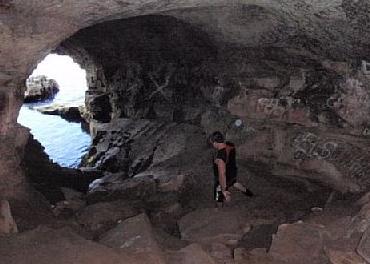A Canadian Fairy Hole (with Wigwam) October 21, 2016
Author: Beach Combing | in : Contemporary, Modern , trackback
The Fairy Hole on Cape Breton in Nova Scotia is a huge cave on a mountain side, some twenty yards across. There are several videos on youtube that give some sense of what it is like inside and immediately outside.
Beach was interested by this site because Fairy Hole is a common placename in England, particularly northern England. The suggestion, found in many Nova Scotian guide books, that this name was given by Irish or Scottish settlers seems unlikely: as the name Fairy Hole was not used in either Ireland or the Highlands (it was used in the Scottish Lowlands).* One striking difference with the Old World fairy holes is the size. The English Fairy Holes are usually tiny things that child-sized fairies could perhaps squeeze into: these fairy holes are, in fact, an excellent proof for the size of traditional fairies.
So why did the cave get this name? Well, fairylore was strong in the Maritimes and, to the north, Newfoundland and there are other fairy placenames in Atlantic Canada. But there might be another reason. Hornborg in Mi’kmaq Landscapes quotes Speck
Gluskap was the god of the Micmacs. The great deity, Ktcini’sxam, made him out of earth and then breathed on him, and he was made. This was at Cape North (KtE’dnuk, ‘At the North Mountain’), Cape Breton, on the eastern side. Gluskap’s home was at Fairy Holes (Gluska’be wi’gwôm, ‘Gluskap’s wigwam’.) Just in front of the caves at this headland are three little islands in a straight line, long and narrow, known as Ciboux Islands. These are the remains of Gluskap’s canoe, where he left it when it was broken.
So we seem to have an indigenous and a European tradition reporting a supernatural place. Or is there more? P. 90 Hornborg writes that
Wallis and Parsons also tell of a visit in a magical cave. Wallis’s informant John Newell says that in a mountain on Cape Breton there is a big cave that is Kluskap’s cabin. He does not give the name of the place, but it is probably the same as is mentioned by Speck. There is a good chance that Newell had heard the story when he was young, since he stayed on the island until he was twenty, at which age he moved to Pictou Landing on the mainland. He tells that some men with torches went into the cave to explore it. As was the custom, they first put a stick at the entrance, so that the opening would not be closed. The men did not notice anything particular in the cave. According to Newell, the Mi’kmaq long ago believed that, through the cave, they could reach the land of the stone dwarfs.
Did early English settlers learn about the stone dwarfs and translate this into their own supernatural terms? Drbeachcombing At yahoo DOT com
*Note that in the Maritimes and Newfoundland anything to do with the fairies is commonly and often correctly ascribed to Irish settlers.
Southernman writes in pointing out a new source, Helen Creighton’s Bluenose magic: expect more from this in later posts. HC wrote ‘Micmacs may go for a long distance in this cave, but lights of the whites go out’, so there!


